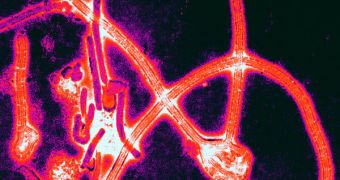Normally, there is no cure or vaccine for the Ebola virus, but a new research carried out by scientists at the University of Illinois at Chicago discovered a family of small molecules that can bind to the outer protein coat of the virus and prevent it from entering human cells.
Duncan Wardrop, associate professor of chemistry at UIC and corresponding author of the new study, worked with UIC virologist Lijun Rong, who created a screening system that uses a chimeric HIV-Ebola virus bearing the protein coat of the Ebola virus.
The real Ebola virus causes deadly hemorrhagic fever in humans, but this one being a chimera, it looks like Ebola but isn't life-threatening for scientists to work with.
The researchers worked on over 230 candidate compounds before finding two molecules that inhibited cell entry, one of which is specific for the Ebola and also for another virus.
Wardrop said that the “lead compound also inhibits Marburg,” which is a related virus as deadly as the Ebola.
“That was a nice surprise.
“There's growing evidence the two viruses have the same cell-entry mechanism, and our observations appear to point to this conclusion.”
The research for even more potent anti-Ebola agents never ends, so Wardrop and graduate student Maria Yermolina, worked on a series of derivatives of this lead molecule (a member of the isoxazoles family), and found several others that displayed a high activity against Ebola infection.
Michael Caffrey, associate professor of biochemistry and molecular genetics, is now working on finding out how and where these small molecules bind to the virus's protein coat, by using nuclear magnetic resonance spectroscopy.
Wardrop says that even if it might be too early to make predictions about a new treatment for Ebola or Marburg infections, theses positive results give the scientists hope.
Their nest step is to test whether the small-molecule treatments are effective in animal models, hoping that these findings will give further insight into the mechanisms used by these viruses to enter human cells.
“This knowledge may spur development of new anti-viral agents,” said Wardrop.
“From a wider perspective, we're searching for compounds to use as probes to study biological processes.
“Small molecules which bind to specific proteins and alter their function are invaluable to understanding what these proteins do in living cells,” he added.
Small molecules were proven to interfere with the Ebola infection process by prior research, Wardrop said, but it seemed that all of these compounds “appear to exert their effects by altering the cells' response to the virus once it's entered the cell -- by which time it's too late.”
The novelty of this new research is that it proves that small molecules can bind to the virus before it enters the cell, thus preventing infection.
This research received major finding from the National Institutes of Health, the results are now online and they will be published in the Journal of Medicinal Chemistry.

 14 DAY TRIAL //
14 DAY TRIAL //